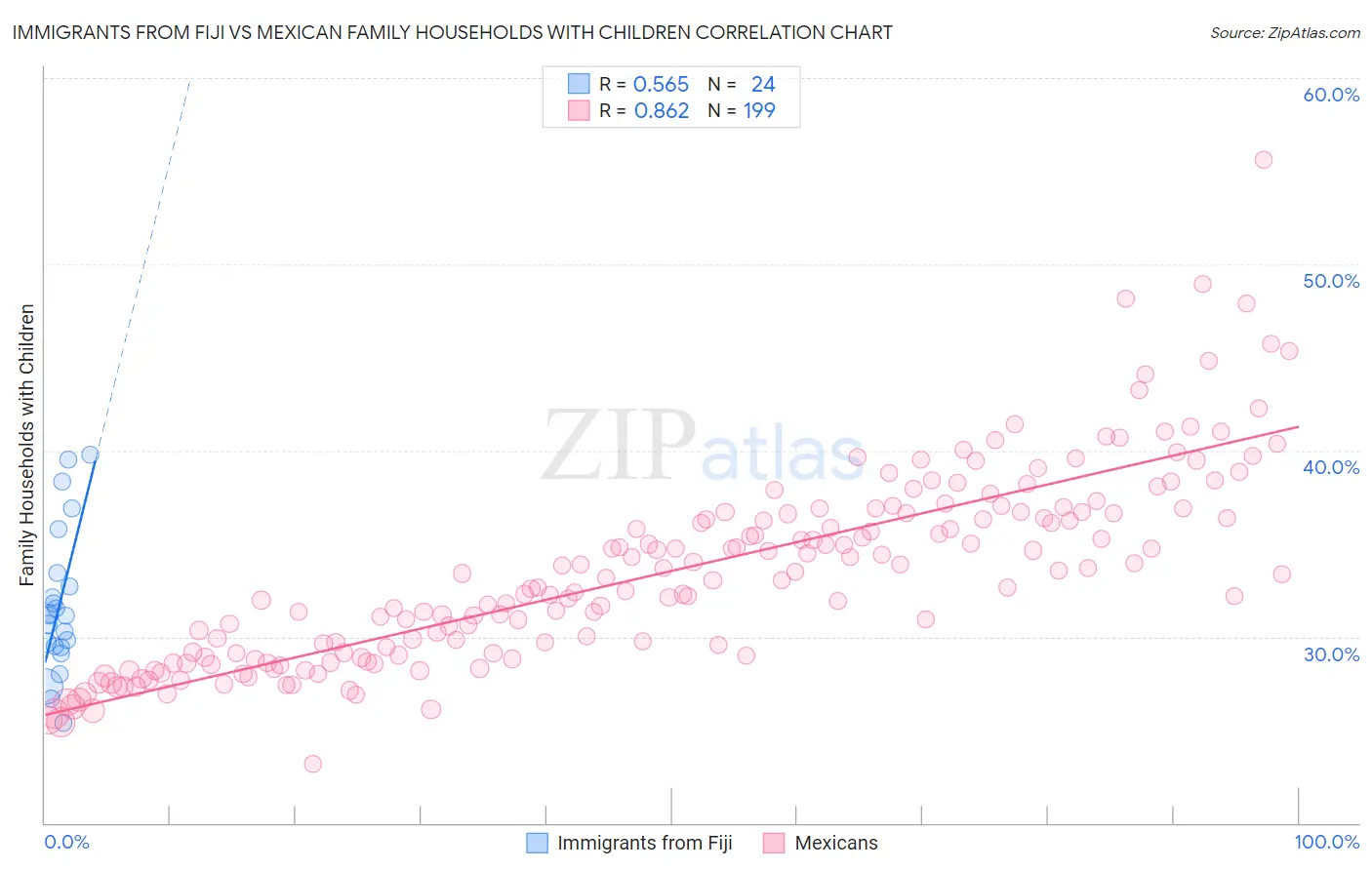Immigrants from Fiji vs Mexican Family Households with Children
COMPARE
Immigrants from Fiji
Mexican
Family Households with Children
Family Households with Children Comparison
Immigrants from Fiji
Mexicans
30.5%
FAMILY HOUSEHOLDS WITH CHILDREN
100.0/ 100
METRIC RATING
10th/ 347
METRIC RANK
31.4%
FAMILY HOUSEHOLDS WITH CHILDREN
100.0/ 100
METRIC RATING
4th/ 347
METRIC RANK
Immigrants from Fiji vs Mexican Family Households with Children Correlation Chart
The statistical analysis conducted on geographies consisting of 93,754,712 people shows a substantial positive correlation between the proportion of Immigrants from Fiji and percentage of family households with children in the United States with a correlation coefficient (R) of 0.565 and weighted average of 30.5%. Similarly, the statistical analysis conducted on geographies consisting of 564,219,663 people shows a very strong positive correlation between the proportion of Mexicans and percentage of family households with children in the United States with a correlation coefficient (R) of 0.862 and weighted average of 31.4%, a difference of 2.7%.

Family Households with Children Correlation Summary
| Measurement | Immigrants from Fiji | Mexican |
| Minimum | 25.4% | 23.2% |
| Maximum | 39.8% | 55.6% |
| Range | 14.4% | 32.5% |
| Mean | 31.7% | 33.5% |
| Median | 31.2% | 33.1% |
| Interquartile 25% (IQ1) | 29.4% | 29.1% |
| Interquartile 75% (IQ3) | 33.1% | 36.6% |
| Interquartile Range (IQR) | 3.6% | 7.6% |
| Standard Deviation (Sample) | 3.9% | 5.2% |
| Standard Deviation (Population) | 3.8% | 5.2% |
Demographics Similar to Immigrants from Fiji and Mexicans by Family Households with Children
In terms of family households with children, the demographic groups most similar to Immigrants from Fiji are Nepalese (30.5%, a difference of 0.080%), Thai (30.6%, a difference of 0.32%), Yakama (30.8%, a difference of 0.80%), Immigrants from Pakistan (30.2%, a difference of 0.96%), and Afghan (30.2%, a difference of 1.2%). Similarly, the demographic groups most similar to Mexicans are Tongan (31.2%, a difference of 0.41%), Immigrants from Mexico (31.6%, a difference of 0.78%), Immigrants from India (31.0%, a difference of 1.0%), Immigrants from Central America (31.0%, a difference of 1.3%), and Yakama (30.8%, a difference of 1.9%).
| Demographics | Rating | Rank | Family Households with Children |
| Yup'ik | 100 /100 | #1 | Exceptional 37.0% |
| Inupiat | 100 /100 | #2 | Exceptional 32.8% |
| Immigrants | Mexico | 100.0 /100 | #3 | Exceptional 31.6% |
| Mexicans | 100.0 /100 | #4 | Exceptional 31.4% |
| Tongans | 100.0 /100 | #5 | Exceptional 31.2% |
| Immigrants | India | 100.0 /100 | #6 | Exceptional 31.0% |
| Immigrants | Central America | 100.0 /100 | #7 | Exceptional 31.0% |
| Yakama | 100.0 /100 | #8 | Exceptional 30.8% |
| Thais | 100.0 /100 | #9 | Exceptional 30.6% |
| Immigrants | Fiji | 100.0 /100 | #10 | Exceptional 30.5% |
| Nepalese | 100.0 /100 | #11 | Exceptional 30.5% |
| Immigrants | Pakistan | 100.0 /100 | #12 | Exceptional 30.2% |
| Afghans | 100.0 /100 | #13 | Exceptional 30.2% |
| Bangladeshis | 100.0 /100 | #14 | Exceptional 30.1% |
| Immigrants | South Central Asia | 100.0 /100 | #15 | Exceptional 30.0% |
| Immigrants | Afghanistan | 100.0 /100 | #16 | Exceptional 30.0% |
| Hispanics or Latinos | 100.0 /100 | #17 | Exceptional 29.9% |
| Salvadorans | 100.0 /100 | #18 | Exceptional 29.9% |
| Alaska Natives | 100.0 /100 | #19 | Exceptional 29.9% |
| Immigrants | El Salvador | 100.0 /100 | #20 | Exceptional 29.8% |